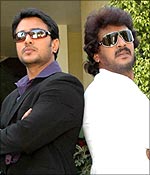|
|
| Help | |
| You are here: Rediff Home » India » Movies » Interviews |
|
 A still from the movie, Toss. | ||
| |||||||||||||||||||||||
|
| |||||||||||||||||||||||
If you make a film, make it for the audience," says Ram Reddy, or Priyadarshini Ram as he is better known. And true to his words, the filmmaker promises a mainstream film with his latest venture, Toss, starring Kannada superstar Upendra, Raja and Priyamani.
The filmmaker, who veered away from advertising with Manodu, says Toss is different from his debut film. "Manodu was a movie where I wanted to say something. It was to do with the youth running away to the city from the rural areas," he said.
"Toss and Manodu are like the mango and neem trees," he continues. "Both are nurtured well but the mango turns out to be sweet and the neem bitter. Everybody wants the mango. Who wants the bitter stuff? Nobody."
What is also different is the way the film was shot. Toss happens to be the first film in India to be shot on Viper filmstream, a third generation high definition camera (which was used to shoot Collateral and Zodiac).
"This Rs 7 crore camera was bought by Basi Reddy to India. The post-production is exciting. Normally shooting is done on negative and then digitised. When Filmstream is being used there is no necessity of scanning. One can work straight away on computer graphics," he says.
 "Also, the post-production equipment is different. In fact one can shoot the film and immediately do the rough editing. Filmstream is a good tool for the director. The camera works well even in low light conditions," he added.
"Also, the post-production equipment is different. In fact one can shoot the film and immediately do the rough editing. Filmstream is a good tool for the director. The camera works well even in low light conditions," he added.
Most of the film was shot in Hyderabad, while some portions were shot in Malaysia.
Talking about the storyline, Ram says the film is "essentially about who is morally right or who is systemically right. Every human being is intrinsically right and I would say society is judgemental."
Giving an example he says, "If we stand in front of the mirror, the right hand becomes the left hand. We, as individuals, put on an act. Deep down we are something different. Unless something churns us inside out the other side does not show up.
"Similarly if you meet a murderer in jail he'll convince you and make you feel he has done the right thing. Society will judge him right or wrong but he feels he has done the right thing," he continues.
Ram wrote the story in one night. He began with the following lines Oka abbadam padi saari nijam ante adi nijam kavochu. Kaani oka nijam vanda saari abaddam anna athi abaddam kaadu (One lie uttered 10 times as though the truth can become the truth but one truth even if uttered 100 times as though a lie cannot become a lie).
"Not everything you see is the truth. There is a hidden image versus reality, and that forms the crux of the story," he adds.
 Speaking about the cast, Ram says Upendra and Raja were the first choices for the film. Ram was fortunate to get Upendra for the film. The actor will be seen after five years in a Telugu film.
Speaking about the cast, Ram says Upendra and Raja were the first choices for the film. Ram was fortunate to get Upendra for the film. The actor will be seen after five years in a Telugu film.
"Upendra normally takes two years before he decides to act in a film as he also directs. He gave me 10 minutes to hear the lines of the movie. I started the narration and he agreed to do it within a few minutes. After that we sat for almost five hours discussing the film and its technical aspects."
As for Priyamani, Ram chose her after seeing her performance in Pellaina Kothalo. "She has a pleasant face and I thought she could carry her role well."
For the music, Ram approached Mani Sarma. "I call him the magician. Normally he doesn't work with new directors, but when I told him the story line he agreed. His music has body, it is expressive."
Ram has in fact even penned lyrics for a song.
But when all is said and done, the fillmmaker believes that all cinema should start with "relatability and rise to a level of aspiration."
"The character should be born like a man in the audience but it should do something beyond him. Then only will the movies be successful. The audience has to get involved.
"Cinema is primarily for entertainment and there are rules to be followed in cinema. Entertainment is gripping story telling where one forgets oneself. That is why script and screenplay are important. Techniques are to be used to enhance the story," he continues.
Is it easier holding the attention of the audience in an advertisement as compared to a film?
"Yes," says the filmmaker. "To hold the attention of the audience is quite a challenge. It is easier in a 30-second film as compared to a feature film," Ram says adding that "nobody knows what the audience wants. Story is driven by the character. If the character's acts are justified then the film works."
|
|
| © 2007 Rediff.com India Limited. All Rights Reserved. Disclaimer | Feedback |